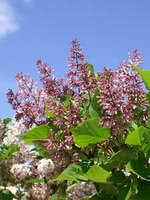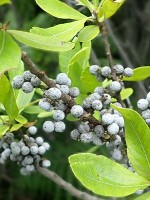Mon-Fri 9am - 5pm Mountain time
Manchurian Lilac (Korean Lilac) vs Northern Bayberry
Syringa pubescens ssp. patula
Myrica pensylvanica
NOT AVAILABLE THIS SEASON - MIGHT RETURN
NOT AVAILABLE THIS SEASON - MIGHT RETURN
Manchurian Lilac (aka Korean Lilac) is a medium-sized shrub that features fragrant clusters of pale purple flowers in late spring.
Manchurian Lilac is less affected by disease than other lilacs and will create a beautiful border, hedge, or privacy screen. If you are looking for a lilac for your shelterbelt, consider Common Purple Lilac or Villosa Lilac first.
Northern Bayberry makes an excellent hedge or feature shrub. It will retain its leaves in warmer climates but drops them in colder areas. They produce blue-grey berries that have a wax coating on them that can be used to make candles or soaps.
In colder hardiness zones the leaves turn an attractive orange to red colour in the fall, making it a striking addition to your landscape.
Northern Bayberry is native to Nova Scotia and tolerates both drought and wet conditions. It is also a nitrogen fixer that tolerates poor soil conditions.
Manchurian Lilac (Korean Lilac) Quick Facts
Northern Bayberry Quick Facts
Toxicity: Warning: The wax from bayberry fruit is considered toxic and may be carcinogenic.

